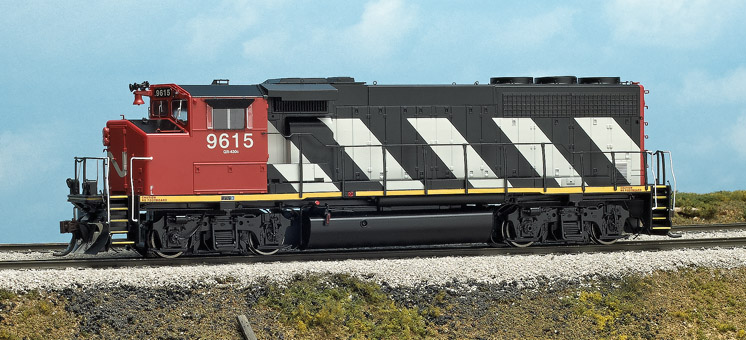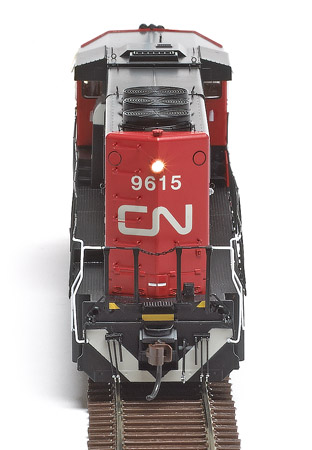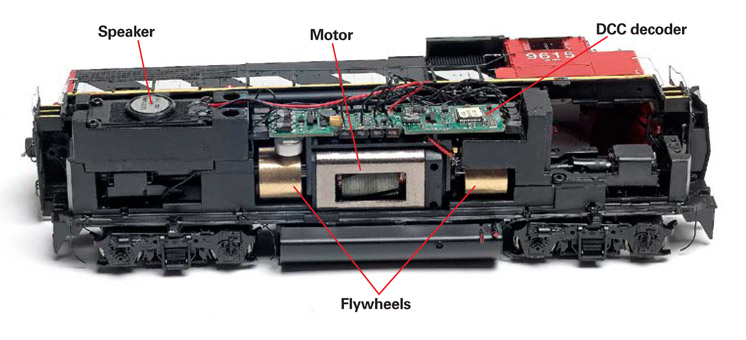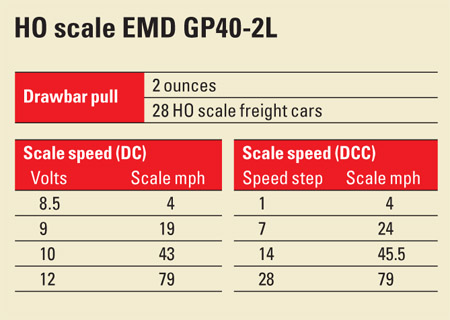Division GP40-2 is no exception. The Digital Command Control version includes a dual-mode SoundTraxx DCC sound decoder, which makes this Geep sound as good as it looks.
The prototype. In 1972 EMD introduced the 3,000 hp GP40-2. Between 1974 and 1976, General Motors Diesel, the Canadian subsidiary of EMD, built a modified GP40-2 for Canadian National. The biggest difference between the Canadian and U.S. version was the wide “comfort” cab on the CN Geeps. In addition to better collision protection, these cabs included crew amenities like refrigerators and hot plates. This type of cab is now called the North American cab and is common on most EMD and General Electric diesels.
The GP40-2L had a lighter and taller frame than a standard GP40-2, allowing it greater sand and fuel capacities, while meeting CN’s weight and axle loading restrictions for branch lines. The last group of CN GP40-2s (nos. 9633 to 9667), referred to as GP40-2(W), had wide cabs but rode on standard GP40-2 frames. Canadian commuter carrier GO Transit purchased 11 GP40-2(W) locomotives in the 1970s, 10 of which the railroad ended up selling to the CN in 1991.
Many of the GP40-2L and GP40-2(W) fleet are still on the CN’s roster. Some have been sold to short lines, such as Guilford and Huron & Eastern.
All the detail on the plastic model matched prototype photos of a GP40-2L. The model includes the correct 3,600 gallon fuel tank vs. the 3,200 gallon tank found on GP40-2 and GP40-2(W) locomotives. The position of the horn above the bell is also correct for the model early in its career.
Other separate detail parts include scale profile handrails, m.u. hoses, and uncoupling levers. These parts are all made of flexible plastic to resist breaking. The sand lines are also flexible plastic, and are positioned high enough not to snag on turnouts or other trackwork.
Cab interior detail includes seats and a brake stand. Hand grabs and windshield wipers are separately applied. Crew figures aren’t included.
The dual headlights in front and single headlight on the rear as well as the “lampshade” ditch lights are correct, as are the non-functioning class lights on the front of the cab. There is a gap between the front headlight housing and the short hood. The plastic headlight housing also glows when the headlight is illuminated. This could be fixed by painting the inside of the housing black to help block the light.
The model’s zebra-stripe paint scheme matches as-built prototype photos, including the white V stripe on the snow plow. There’s sharp separation between all the colors, and the warning stencils are legible under magnification.
Lighting leads run from the decoder to incandescent light bulbs in the body shell. I like the realistic warm yellow glow that these bulbs provide.
With the decoder set to 28 speed steps, the GP40-2L accelerated smoothly to a top speed of 79 mph. This speed is close to that of the first 50 GP40-2Ls, which featured 60:17 gearing and a top speed of 80 mph. The rest of the fleet featured 62:15 gearing and a 65 mph top speed.
The decoder supports 128 speed steps and includes 14 preset speed tables. There’s also a custom speed table setting and forward and reverse trim, which are all useful features for speed matching two or more locomotives. GP40-2s often ran in m.u. configuration. I advance consisted our review sample GP40-2L with an Athearn CN GP38-2W.
The model’s 2 ounce drawbar pull is typical for a four-axle HO diesel without traction tires. In a hill climb test the GP38-2L hauled 10 freight cars up a 3 percent grade without stalling.
DCC sounds and lights. The Athearn GP40-2L features the accurate sounds of a turbocharged EMD 645 diesel engine. In addition to setting the number of speed steps for each throttle notch, the decoder can be set for manual notching where the engine rpm is controlled independent of the locomotive speed.
User-controlled functions include the brake release, coupler, and bell. The long and short blast of the Nathan K-3 air horn sound correct. Function 4 triggers dynamic brake fan sounds, which aren’t necessary since a prototype GP40-2L doesn’t have dynamic brakes.
The ability to fine-tune sound is a hallmark of SoundTraxx decoders. There’s a seven-band equalizer and
reverb controls. I find the ability to control the volume of each individual sound effect to be the most useful feature.
The headlights and ditch lights are controlled with separate function buttons. The headlights operate automatically according to the locomotive’s direction of travel. While this is a common feature on models, it isn’t how the prototype works. For more realistic operation, it’s easy to remap the locomotive functions for independent control of the front and rear headlights.
Direct-current operation. The dual-mode SoundTraxx decoder supports DC operation. Like most sound decoders, it requires a lot of voltage (8.5 volts) to get moving. Adjusting the analog starting voltage (CV63) does help smooth out performance somewhat, but requires some trial and error. No matter what the setting, the sound cut out whenever I flipped the direction switch on the DC power pack, which I found distracting.
The engine rpm increase and decrease with the throttle and the bell automatically turns on at speeds under 20 scale mph. A quick increase in the throttle triggers a grade crossing horn signal. The other sound features can be accessed in DC using a DC sound controller, such as the Model Rectifier Corp. Tech 6.
Canadian classic. Especially in DCC, the Athearn model ran as reliably as its long-serving prototype. The model is better detailed than many brass diesel models that I’ve seen. This CN Geep would be the star of any HO scale diesel roster.
Manufacturer
Athearn Trains
1600 Forbes Way, Ste. 120
Long Beach, CA 90810
www.athearn.com
Era: 1974 to 1990s (as detailed)
Features
- All-wheel drive and electrical pickup
- Constant incandescent lighting
- DCC Quick Plug accepts eight- and nine-pin DCC decoders
- Dual-mode SoundTraxx DCC sound decoder (DCC version)
- McHenry plastic knuckle couplers at correct height
- Metal RP-25 contour wheels in gauge
- Weight: 13.9 ounces

















